
One of the best scenes in any superhero movie comes towards the end of Sam Raimi’s seminal Spider-Man 2 when Aunt May gives a troubled Peter some words of wisdom. “I believe there’s a hero in all of us, that keeps us honest, gives us strength, makes us noble. And finally gets us to die with pride,” she says, referring to Spider-Man’s importance to a young boy in the neighbourhood. “Even though sometimes we have to be steady and give up the thing we want most — even our dreams.”
In the context of the film, it’s a powerful reminder for Peter of the great power and responsibility he holds, motivating him to become Spider-Man once again to save the day. But it’s an ethos that’s also intrinsic to developer Insomniac’s Marvel’s Spider-Man 2. Building off its 2018 and 2020 predecessors, Marvel’s Spider-Man 2 hones in on the idea of everyday heroism more than ever for the webslinger.
Regardless of the obstacles they face, everyone — be it a pair of spider-themed superheroes, a prospective Daily Bugle photographer inspired by Peter Parker, an elderly man who feeds the pigeons, or a deaf artist in Harlem — can make a difference.
This focus gives Marvel’s Spider-Man 2 a thematic core that’s among the strongest of any Spider-Man tale, reinforced through immaculate storytelling, incredible gameplay and some top-notch sidequests. Amid a stacked year for games, Insomniac has delivered what’s easily one of 2023’s best.
Be greater — together
Over the years, we’ve gotten many stories featuring multiple Spider-Men, from Spider-Man: The Animated Series‘ two-part finale and The Clone Saga comics in the ’90s to, more recently, the Spider-Verse comic crossover, two animated Spider-Verse films and Spider-Man: No Way Home. In fact, there’s even a video game precedent to this thanks to 2010’s underrated Spider-Man: Shattered Dimensions, which featured four playable wallcrawlers in separate stages.
Generally, these still lean towards one lead Spider-Man, with any others being in more supporting roles. Marvel’s Spider-Man 2 is really the first time we’ve gotten a story with two Spider-Men — in this case, Peter Parker (Yuri Lowenthal) and Miles Morales (Nadji Jeter) — in which they’re both the leads. Moreover, having that dual-protagonist premise in a sprawling open-world game necessitates carefully juggling them in a satisfying way over the course of dozens of hours. It’s an ambitious setup, to be sure, but one that Insomniac balances well thanks to a masterfully paced campaign that sees missions alternate between the two and occasionally even feature both as playable characters.
 Picking up nine months after the events of Miles Morales, Marvel’s Spider-Man 2 sees Peter and Miles trying to start new chapters in their lives. While grieving the loss of Aunt May, Peter finds himself struggling to pay off the mortgage on her home and trying to convince MJ (Laura Bailey) — who’s got her own Daily Bugle baggage — to move in with him. Miles, meanwhile, is still coming to terms with the passing of his father while stressing over a college entry exam and trying to help out his now-single mother Rio (Jacqueline Pinol). These are the sort of everyday personal problems that make Spider-Man so relatable, and Insomniac commendably devotes ample time to exploring the toll they’re having on our heroes and their loved ones.
Picking up nine months after the events of Miles Morales, Marvel’s Spider-Man 2 sees Peter and Miles trying to start new chapters in their lives. While grieving the loss of Aunt May, Peter finds himself struggling to pay off the mortgage on her home and trying to convince MJ (Laura Bailey) — who’s got her own Daily Bugle baggage — to move in with him. Miles, meanwhile, is still coming to terms with the passing of his father while stressing over a college entry exam and trying to help out his now-single mother Rio (Jacqueline Pinol). These are the sort of everyday personal problems that make Spider-Man so relatable, and Insomniac commendably devotes ample time to exploring the toll they’re having on our heroes and their loved ones.
Naturally, things only get worse once Kraven the Hunter (Jim Pirri) arrives in New York and begins freeing other villains as part of his own twisted quest to eliminate Spider-Man. Along the way, Peter is reunited with his childhood friend Harry (Graham Phillips), who’s facing a deadly illness that’s being treated with the iconic black symbiote. Eventually, the symbiote finds its way onto Peter, putting him on a darker and more vengeful path that endangers Miles, MJ, and co. and, eventually, ushers in the classic Spidey villain Venom.
While the symbiote saga has been tackled many times before, Insomniac’s version feels more meaningful than most because it’s contextualized by the events of the first game. Peter’s heartbreak over the death of Aunt May and betrayal of his mentor, Otto Octavius, is compounded by the threat of losing his oldest and dearest friend, making his feelings of anger, resentment, and desperation all the more understandable. This, in turn, reinforces the concept of heroism — the idea that nobody is perfect and we all stumble. It’s the core appeal of the symbiote story; the idea that even someone as kind-hearted as Peter can still have a darkness in him and lash out at those he loves, but ultimately, he overcomes it, and it’s remarkably uplifting.
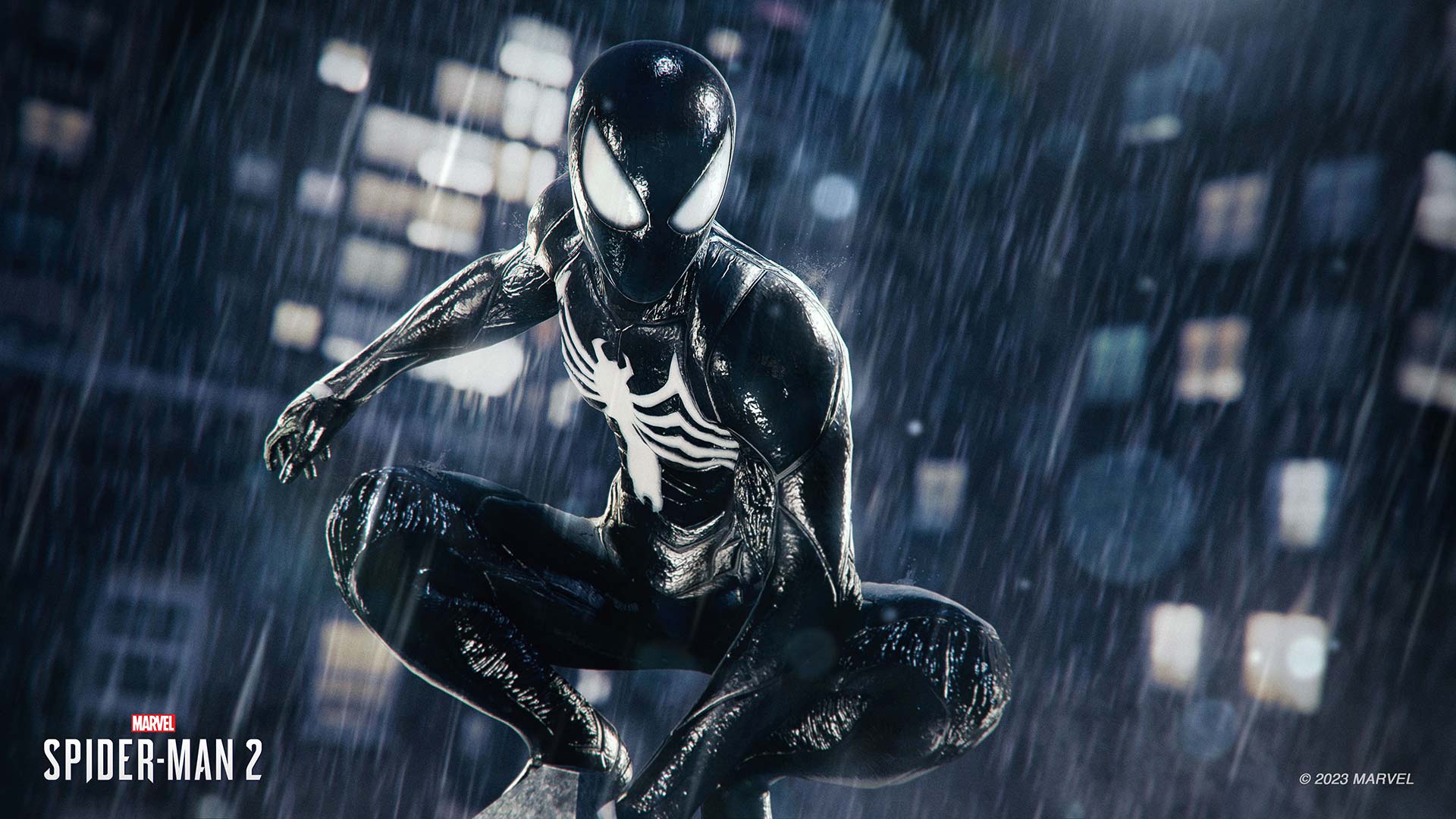 The reason this arc works so well, to begin with, is because we don’t just care about Insomniac’s well-written version of Peter, but also the entire supporting cast. MJ suffers under J. Jonah Jameson to use the Bugle‘s platform to reach the most people possible with her essential journalism while trying to make things work with Peter. Rio puts aside her own grief to be there for her son and the people of Harlem. The good-natured Ganke always manages to make time to offer crime-fighting tech support to both Miles and Peter.
The reason this arc works so well, to begin with, is because we don’t just care about Insomniac’s well-written version of Peter, but also the entire supporting cast. MJ suffers under J. Jonah Jameson to use the Bugle‘s platform to reach the most people possible with her essential journalism while trying to make things work with Peter. Rio puts aside her own grief to be there for her son and the people of Harlem. The good-natured Ganke always manages to make time to offer crime-fighting tech support to both Miles and Peter.
But the standout secondary character, undoubtedly, is Harry Osborn. Rather than rush to give us symbiote Spider-Man, Insomniac wisely devotes several hours to fleshing out Peter and Harry’s relationship. Young Osborn, who is suffering from the same disease that killed his mother, starts a scientific non-profit — the Emily-May Foundation, sweetly named after his and Peter’s respective late maternal figures — to help prevent anyone else from suffering the same fate. It gives this Harry a far more noble and sympathetic motivation than other interpretations we’ve seen. All the while, Insomniac takes the time to illustrate just how much Harry has meant to Peter over the years. In fact, one of the best parts of the entire game is a lovely combat-free sequence in which Peter, Harry and MJ simply walk around Coney Island, playing carnival games, screaming on roller coasters and catching up on old times. You really feel the connection between them, and it solidified this version of Harry as my favourite outside of the comics.
“Marvel’s Spider-Man 2 is a monumental achievement.”
What Marvel’s Spider-Man 2 also has that most other takes on the symbiote saga don’t is Miles, whose endearing brotherly relationship with Peter helps shine a light through the elder Spider-Man’s darkness. Peter has just as much to learn from Miles as Miles does through him, and it makes their bond all the more affecting. That said, just like MJ, Miles isn’t here solely to prop up Peter; he’s absolutely his own man with his own equally compelling journey. If Insomniac’s previous games were about Miles taking his first steps to becoming a hero, Marvel’s Spider-Man 2 is all about him truly learning what it means to be one. From his engrossing arc about dealing with his father’s killer, Mr. Negative (Stephen Oyoung) to admirable efforts to balance crimefighting with being there for his mother, navigating his feelings towards Hailey (Natasha Ofili), the kind and supportive deaf artist from Miles Morales, and moving on to college, the young hero goes on a moving coming-of-age journey.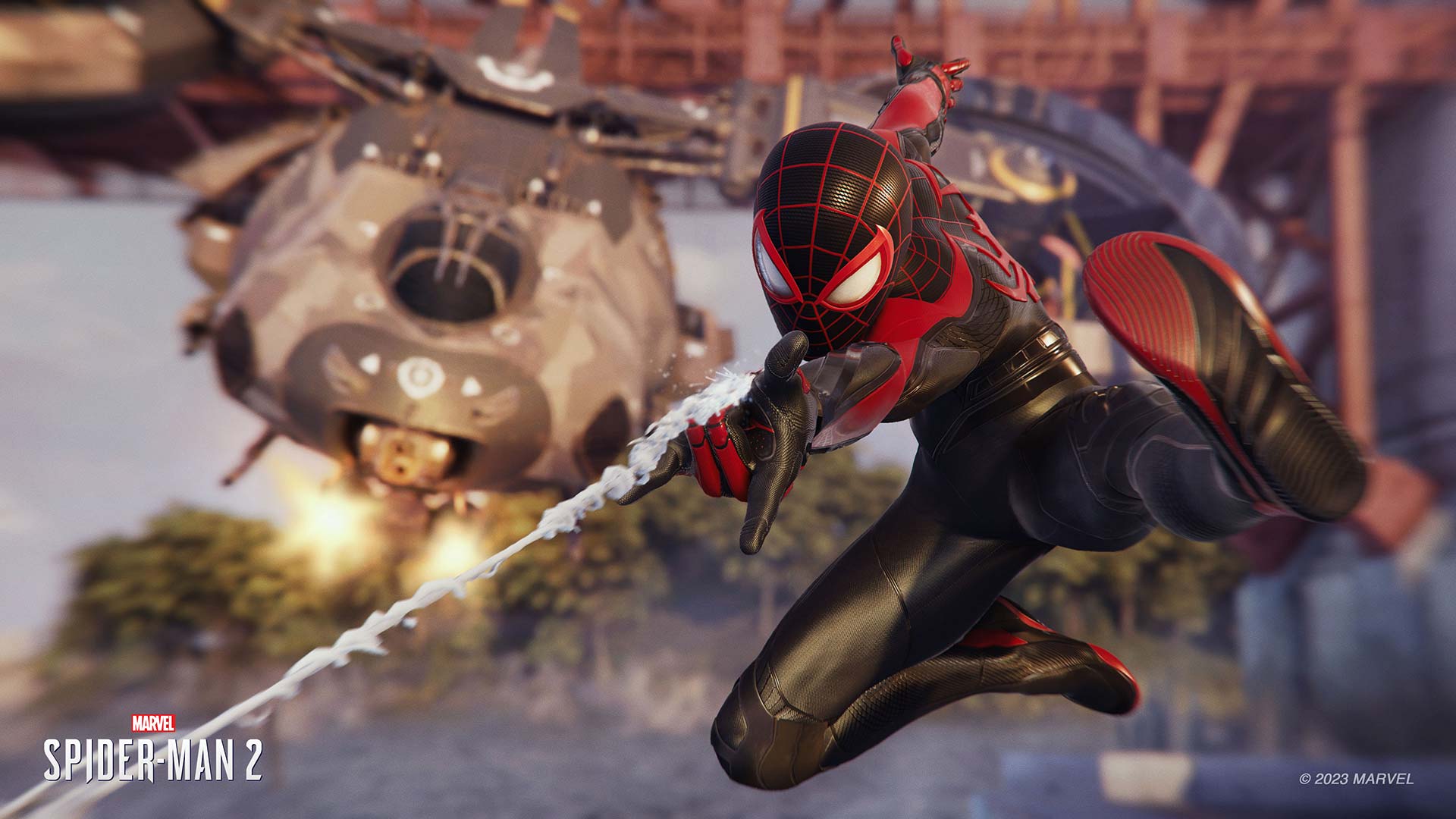 The only area in which the story suffers is Kraven. For much of the game, he hides in the shadows and sends his henchmen or the Lizard to do his dirty work. Whenever he’s actually on-screen, he’s a commanding force, to be sure — it’s just not quite often enough to leave a lasting impact. It’s a testament to the strength of the interpersonal conflicts that there’s still plenty of drama throughout. What’s more, Venom himself more than makes up for Kraven come the third act, offering a much more personal conflict for our Spider-Men that’s masterfully conveyed through a commanding performance from Candyman star Tony Todd and further elevated by smart use of the PS5’s 3D Audio to give it an unsettling, multidirectional edge.
The only area in which the story suffers is Kraven. For much of the game, he hides in the shadows and sends his henchmen or the Lizard to do his dirty work. Whenever he’s actually on-screen, he’s a commanding force, to be sure — it’s just not quite often enough to leave a lasting impact. It’s a testament to the strength of the interpersonal conflicts that there’s still plenty of drama throughout. What’s more, Venom himself more than makes up for Kraven come the third act, offering a much more personal conflict for our Spider-Men that’s masterfully conveyed through a commanding performance from Candyman star Tony Todd and further elevated by smart use of the PS5’s 3D Audio to give it an unsettling, multidirectional edge.
Do whatever two spiders can
It’s a cliché at this point to say Insomniac’s games “really make you feel like Spider-Man,” but that’s undeniably what they do. With core momentum-focused swinging mechanics that feel tight, fluid and precise, and surprisingly engaging melee combat that avoided feeling like another Batman: Arkham clone by emphasizing seamless ground-to-aerial-and-back punches, kicks and web attacks, Insomniac created the quintessential Spider-Man simulator.
How, then, do you improve upon that already strong foundation? Well, it turns out the answer was on the cover of Spider-Man’s very first comic, Amazing Fantasy #15. As depicted in that iconic artwork and miscellaneous stories ever since, Marvel’s Spider-Man 2 now features web wings. Besides offering a nice nostalgic throwback, they offer what’s easily the sequel’s greatest innovation.
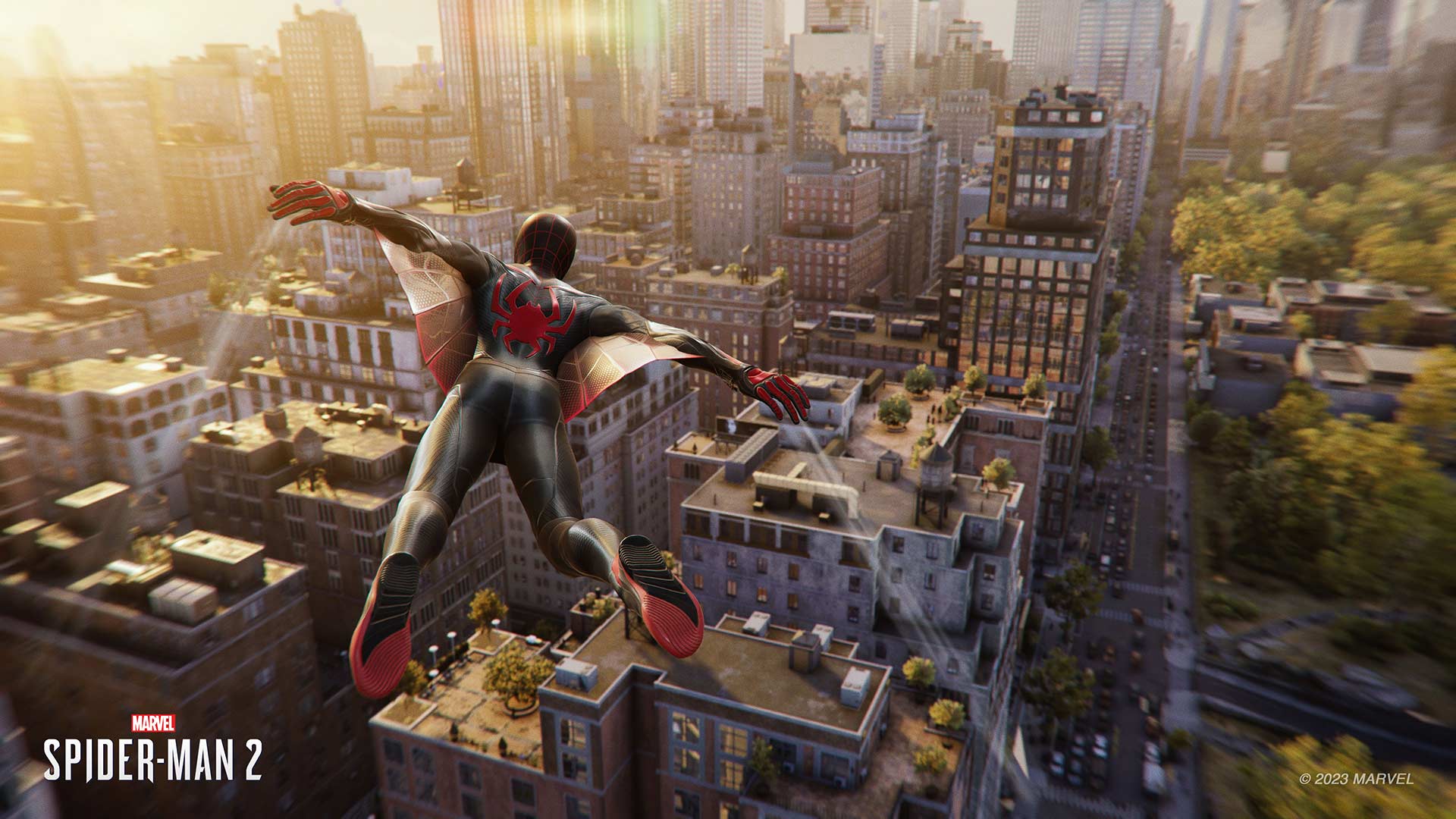 At any point while airborne as either Spider-Man, you can tap triangle to spread your arms and deploy the wings to enter a gliding state. From there, you can freely control Spidey as he descends, while entering into a dive and then pitching the analogue stick will give you more verticality. Before too long I was gracefully soaring between skyscrapers, under bridges and over parks with a massive grin on my face. The wings prove especially useful in the two new boroughs that Insomniac has added, Queens (Peter’s hometown) and Brooklyn (where Miles’ school is located).
At any point while airborne as either Spider-Man, you can tap triangle to spread your arms and deploy the wings to enter a gliding state. From there, you can freely control Spidey as he descends, while entering into a dive and then pitching the analogue stick will give you more verticality. Before too long I was gracefully soaring between skyscrapers, under bridges and over parks with a massive grin on my face. The wings prove especially useful in the two new boroughs that Insomniac has added, Queens (Peter’s hometown) and Brooklyn (where Miles’ school is located).
Besides housing several character-driven quests for both of our heroes, these locales are refreshingly much more suburban than Manhattan, diversifying the city’s overall layout while also challenging you to use your web wings when crossing over terrain that’s absent of tall buildings. There are even well-placed wind currents near bridges and other structures to better facilitate gliding, so a good enough player could even make it across the city solely with the wings. Of course, it’s most efficient — and just plain fun — to alternate between swinging and gliding.
The web wings also feature perhaps my absolute favourite implementation of DualSense haptic feedback to date thanks to the controller providing appropriate levels of vibration in accordance with the amount of wind resistance you’re facing. It really sells the intensity and reckless abandon of diving as low to the ground as possible before pulling open the wings, zipping between cars and bombing back up to the skies. These high-speed moments warrant playing on Performance Mode for a smooth 60fps, especially since the visuals still look crisp even with the resolution hit.
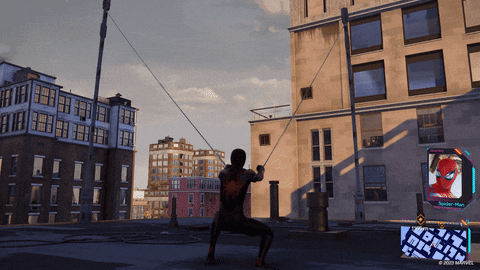 On top of the web wings, traversal has expanded in other ways, too. From a swinging standpoint, the new ability to loop-de-loop 360 degrees with webline momentum is oh-so-satisfying, and you can even do a corner tether to quickly swing around a building, which is clean, snappy and straight out of The Amazing Spider-Man 2. Further, Peter and Miles can now slingshot themselves for a quick burst of speed and distance before swinging, either from anywhere on the ground or specially marked rooftops that provide a more potent launch. And after Miles Morales offered a vastly overhauled and oh-so-stylish new Air Tricks system, Peter himself can also now perform many new maneuvers of his own, including, humourously, turning to face the camera and solving a Rubik’s Cube while falling. All of these mechanics coalesce to offer not only the definitive Spider-Man web-swinging experience, but one of gaming’s all-time greatest traversal systems. There really is nothing quite as fluid, responsive, or liberating.
On top of the web wings, traversal has expanded in other ways, too. From a swinging standpoint, the new ability to loop-de-loop 360 degrees with webline momentum is oh-so-satisfying, and you can even do a corner tether to quickly swing around a building, which is clean, snappy and straight out of The Amazing Spider-Man 2. Further, Peter and Miles can now slingshot themselves for a quick burst of speed and distance before swinging, either from anywhere on the ground or specially marked rooftops that provide a more potent launch. And after Miles Morales offered a vastly overhauled and oh-so-stylish new Air Tricks system, Peter himself can also now perform many new maneuvers of his own, including, humourously, turning to face the camera and solving a Rubik’s Cube while falling. All of these mechanics coalesce to offer not only the definitive Spider-Man web-swinging experience, but one of gaming’s all-time greatest traversal systems. There really is nothing quite as fluid, responsive, or liberating.
A fair number of welcome combat tweaks have also been made. While fights overall feel similar, the flow now feels far more varied and dynamic to a new abilities system. Both Peter and Miles can now use unique moves tied to L1 + each of the face buttons, which really emphasize their unique abilities. For instance, symbiote Peter can shoot forth a massive tentacle to hammer and even stick enemies to walls or floors or grab entire groups with swirling tendrils and slam them to the ground, conveying the earth-shattering power of his new suit. Miles, for his part, has Venom electricity-based attacks that emphasize chaining energy between enemies for maximum effect, such as a Force Lightning-esque jolt or lion-like pounce to shock and hurl one enemy away.
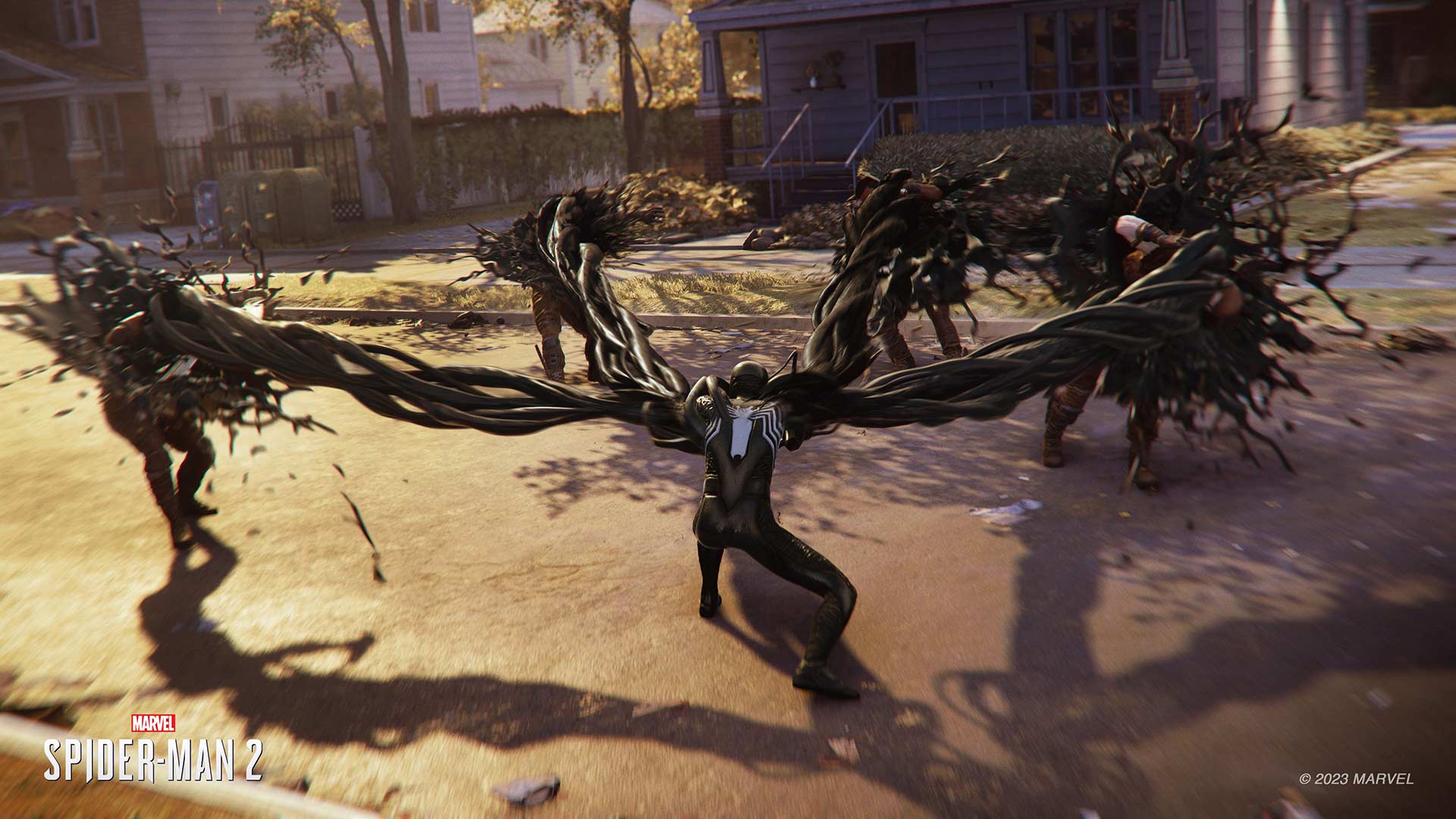 These abilities recharge as you carry out standard melee attacks, so they feel simultaneously useful — especially as you improve them through each character’s unique and shared skill trees — and balanced. At the same time, you also have to contend with a new type of incoming attack that can’t be dodged. Instead, a new parry option has been added to avoid them. While the window for this is fairly forgiving, I appreciated how it prevents you from spamming the dodge button and rewards perfectly timed parries by staggering the enemy.
These abilities recharge as you carry out standard melee attacks, so they feel simultaneously useful — especially as you improve them through each character’s unique and shared skill trees — and balanced. At the same time, you also have to contend with a new type of incoming attack that can’t be dodged. Instead, a new parry option has been added to avoid them. While the window for this is fairly forgiving, I appreciated how it prevents you from spamming the dodge button and rewards perfectly timed parries by staggering the enemy.
The simple parry mechanic also feels appropriate considering fights as a whole feel more challenging, even on Normal difficulty, thanks to a renewed focus on the enemies themselves. Besides sometimes throwing many more of them at you at once, Insomniac’s placement of them within any given combat arena feels more purposeful, as they can perch atop small houses, lampposts and other structures, putting your situational awareness, reaction time and mobility to the task.
It also helps that the enemy variety itself is vastly improved from the previous games. From the returning base brawler and melee weapon wielders to robotic animals that can fly, pin you to the ground or even disable your abilities to, flamethrower-wielding goons, giant sledgehammer and shield mini-bosses and others I won’t spoil, Marvel’s Spider-Man 2 constantly shakes things up with new threats.
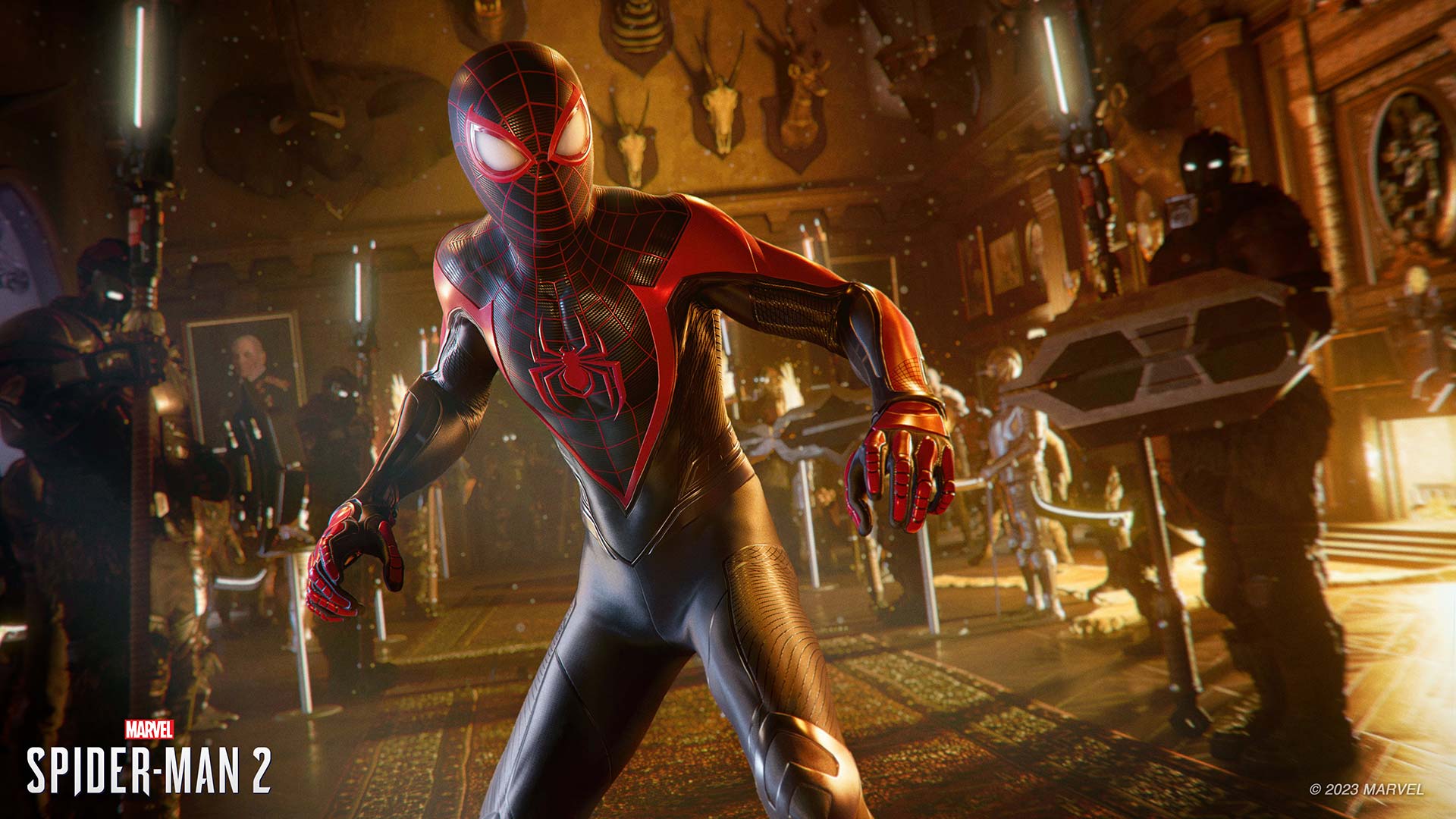 This extends to the boss fights and setpieces, which are among the best I’ve ever seen to feature Spider-Man — games or otherwise. Leveraging the beefier power of the PS5, these grand action scenes seamlessly take you across New York without any load times or — in a welcome deviation from the previous games — almost no quick-time events. That’s right — nearly every moment of these explosive, pulse-pounding moments is in real-time, with you maintaining constant control over your hero. A rage-filled symbiote-wearing Peter having an underground clash of the titans with a monstrous Lizard before bursting to street level and pursuing the horned beast through the streets and up skyscrapers while dodging gunfire from Kraven’s forces. Switching between Miles, who’s frantically swinging around a gargantuan villain and dodging his attacks, and Peter, who’s rushing to ascend a crumbling skyscraper amid hordes of goons. Multiple scenes involving Venom that I won’t dare mention. Throughout the entire campaign, Marvel’s Spider-Man 2 remains consistently breathtaking in scope.
This extends to the boss fights and setpieces, which are among the best I’ve ever seen to feature Spider-Man — games or otherwise. Leveraging the beefier power of the PS5, these grand action scenes seamlessly take you across New York without any load times or — in a welcome deviation from the previous games — almost no quick-time events. That’s right — nearly every moment of these explosive, pulse-pounding moments is in real-time, with you maintaining constant control over your hero. A rage-filled symbiote-wearing Peter having an underground clash of the titans with a monstrous Lizard before bursting to street level and pursuing the horned beast through the streets and up skyscrapers while dodging gunfire from Kraven’s forces. Switching between Miles, who’s frantically swinging around a gargantuan villain and dodging his attacks, and Peter, who’s rushing to ascend a crumbling skyscraper amid hordes of goons. Multiple scenes involving Venom that I won’t dare mention. Throughout the entire campaign, Marvel’s Spider-Man 2 remains consistently breathtaking in scope.
The only area I wish the gameplay was improved is regarding stealth. In the first game, it was serviceable but never quite as engaging as it should have been due to a relative lack of options and an overall feeling of easiness. Miles Morales, to its credit, built upon that by offering camouflage, wall takedowns and enemies who searched up high to prevent you from camping, but Marvel’s Spider-Man 2 doesn’t really expand on this in a meaningful way. On paper, the new ability to create your own weblines should be a game changer as it gives you way more freedom to take down enemies. However, outside of the occasional Kraven drone that slowly flies around to scan for you in the rafters, there isn’t anything else to challenge you, making this feature feel overpowered if anything. Marvel’s Spider-Man 2 also bafflingly brings back the first game’s unpopular MJ stealth missions, which are admittedly better this time around thanks to a few tricks up Ms. Watson’s sleeve but ultimately, they still feel pretty forced and unneeded. The only exception is a surprisingly effective section illustrating, from MJ’s perspective, how terrifying Peter can be in the symbiote.
An even friendlier neighbourhood
 If the main story of Marvel’s Spider-Man 2 is about the people who fight to protect New York on a larger stage, the game’s side content is an ode to those on the ground. The nerdy kid at Miles’ school who galvanizes the community with a prom proposal. A missing elderly man who means the world to his granddaughter. An aspiring photographer who reminds Peter of his own humble beginnings. Even Howard, the old man who had Peter carrying out tedious pigeon-related fetch quests in the first game, gets a surprisingly emotional outing here. Throughout Marvel’s Spider-Man 2‘s litany of side quests, Insomniac puts a face to Spider-Man’s New York in a way that few other stories have done, providing meaningful encouragement to complete them beyond experience and new suits. (There are 60-plus alternate costumes for Peter and Miles drawn from a wonderful array of comic, film and television titles.)
If the main story of Marvel’s Spider-Man 2 is about the people who fight to protect New York on a larger stage, the game’s side content is an ode to those on the ground. The nerdy kid at Miles’ school who galvanizes the community with a prom proposal. A missing elderly man who means the world to his granddaughter. An aspiring photographer who reminds Peter of his own humble beginnings. Even Howard, the old man who had Peter carrying out tedious pigeon-related fetch quests in the first game, gets a surprisingly emotional outing here. Throughout Marvel’s Spider-Man 2‘s litany of side quests, Insomniac puts a face to Spider-Man’s New York in a way that few other stories have done, providing meaningful encouragement to complete them beyond experience and new suits. (There are 60-plus alternate costumes for Peter and Miles drawn from a wonderful array of comic, film and television titles.)
In fact, some of these side stories are even main mission quality. A standout side plot for Peter has him investigating a doomsday cult with an unexpected ally. As I raced across the city to stop the gang’s next attack, I was anticipating one old Spider-Man villain to pop up, only to be pleasantly surprised to discover a different iconic foe entirely. Meanwhile, one of the highlights of Miles’ missions sees him working with Rio to recover stolen musical equipment from his high school. It’s an effective way to explore Miles’ wholesome relationship with his mother while also diving into his love for music. And as a lovely touch, this quest even pays tribute to the pioneering African Americans in the music scene, further emphasizing the central message that anyone — superheroes or otherwise — can make a difference.
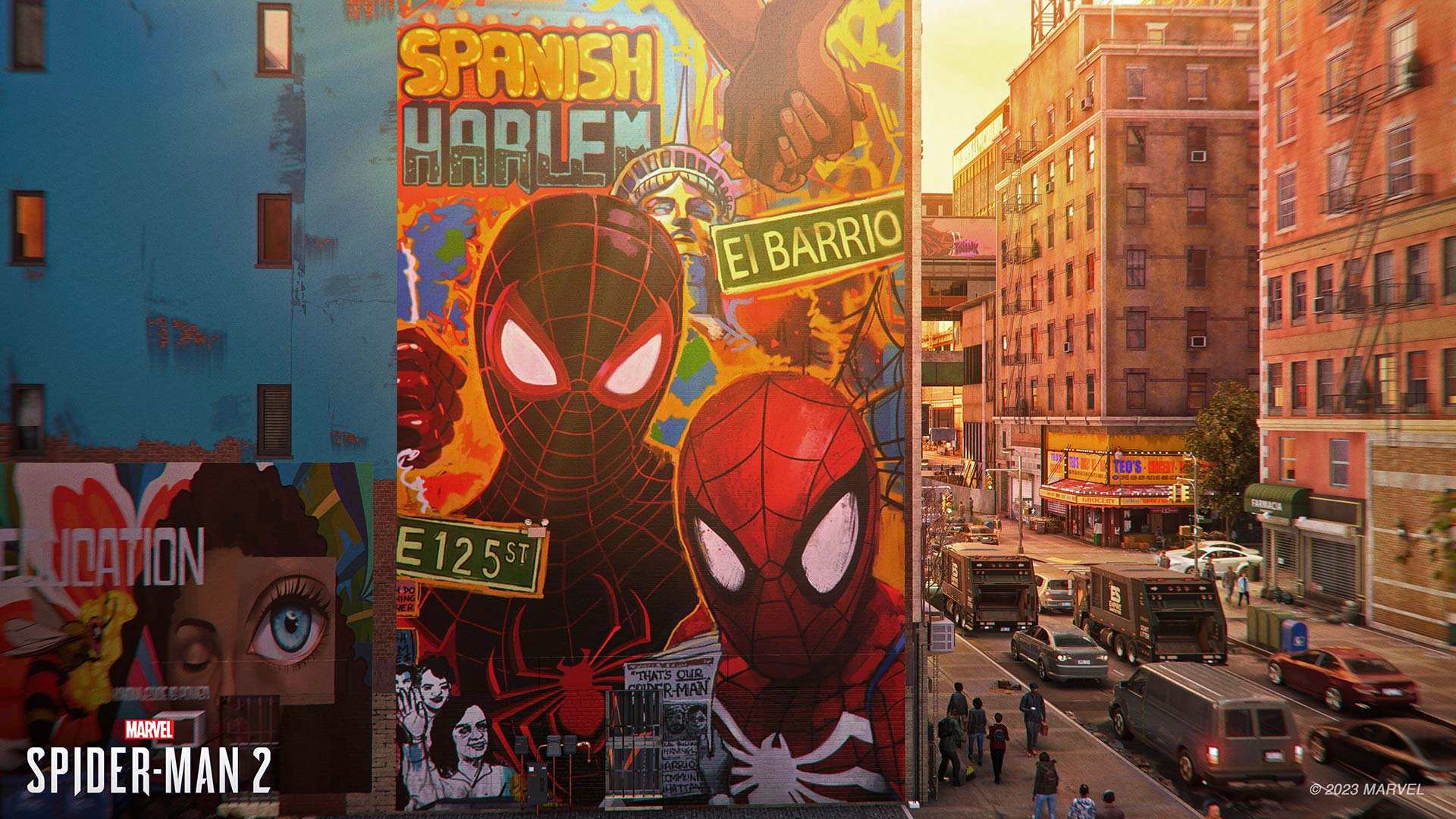 Marvel’s Spider-Man 2 also significantly improves upon the previous games’ rather repetitive random crimes with greater variety through multiple enemy factions and their occasional in-fighting and, best of all, the ability for the Spider-Men to team up. Yes, the other Spider-Men will randomly join you or already be at the scene when you arrive for some fun banter and combo moves. They can even fist-bump and hug each other after the fight, which further conveys their winsome brotherly bond. Mind-blowingly quick character-swapping (plus fast travel!) in the open-world is also possible thanks to the PS5’s SSD.
Marvel’s Spider-Man 2 also significantly improves upon the previous games’ rather repetitive random crimes with greater variety through multiple enemy factions and their occasional in-fighting and, best of all, the ability for the Spider-Men to team up. Yes, the other Spider-Men will randomly join you or already be at the scene when you arrive for some fun banter and combo moves. They can even fist-bump and hug each other after the fight, which further conveys their winsome brotherly bond. Mind-blowingly quick character-swapping (plus fast travel!) in the open-world is also possible thanks to the PS5’s SSD.
However, while Insomniac has drastically upped the overall quality of many of the side missions and random crimes, the overall open-world structure still feels dated. Some of the sidequests devolve into “clear three Kraven hideouts” before revealing the location of a fourth or “complete 10 Mysterio challenges before unlocking his final mission,” which feels especially antiquated in a year with Tears of the Kingdom and Baldur’s Gate 3. To its credit, Insomniac does its best to shake things up within that rigid framework — some neat revelations about Kraven’s family history here, a fun side story exploring Mysterio’s post-prison business ventures there — but juicy narrative morsels aside, the game still would have benefited from a less checklist-heavy approach to some of its optional content.
Conclusion
Marvel’s Spider-Man 2 is a monumental achievement. It tells a rousing story about heroism and resilience that does justice not only to Peter Parker and Miles Morales, but to the friends, family and everyday New Yorkers that surround them. It takes an already stellar gameplay foundation and deepens it through thrilling new traversal and combat mechanics. It provides engrossing and (mostly) varied side content that enriches the world with slice-of-life stories that reflect the world around us. And it provides the number one reason for anyone who’s held off on buying a PS5 to immediately go pick one up.
Not only is Marvel’s Spider-Man 2 the best superhero game ever made — it’s a sensational experience in its own right and one of the best sequels in years.
Marvel’s Spider-Man 2 will launch exclusively on PlayStation 5 on October 20th for $89.96.
MobileSyrup utilizes affiliate partnerships. These partnerships do not influence our editorial content, though we may earn a commission on purchases made via these links that help fund the journalism provided free on our website.
Image credit: PlayStation
MobileSyrup may earn a commission from purchases made via our links, which helps fund the journalism we provide free on our website. These links do not influence our editorial content. Support us here.


